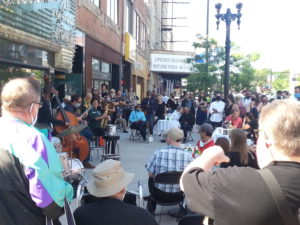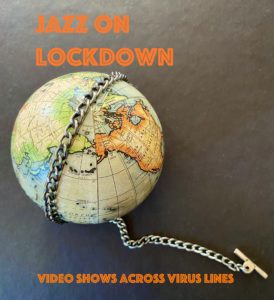In early March – only four months ago – I flew between two of the largest U.S. airports, O’Hare and JFK, to visit New York City. I stayed in an East Village apt. with my daughter and a nephew crashing on her couch. We ate barbecue at a well-attended Jazz Standard performance by drummer Dafnis […]
JazzOnLockdown: Musicians, venues, .orgs — writers? — turn to live-streaming
It’s the most obvious, available and so far low-cost option for anyone who can cast a performance online for public consumption — jazz musicians specifically included: Live-streaming. Fred Hersch has been first out of the box, committing to live-streaming daily mini concerts from his living room, 1pm Eastern Daily Time (10am PST, 7pm in Europe) […]
Jazz Congress, Winter JazzFest, shape of jazz to come
The first Jazz Congress co-hosted by Jazz at Lincoln Center and JazzTimes magazine Jan 11 and 12, 2018 and the 14th annual Winter JazzFest Marathon produced in downtown Manhattan Jan 12 and 13, offered contrasts and prompted crosstalk. It wasn’t like these were conventions of different parties, but different narratives were going down. The Congress’s sessions […]
Women in jazz journalism on gender issues, in NYC MLK weekend
Dr. Martin Luther King Jr. weekend ’18 was a big one for jazz in NYC with the first Jazz Congress at Jazz at Lincoln Center, a glorious Winter Jazz Fest, artists showcases at the conference of APAP (the Association of Performing Arts Presenters) and diverse independent venues — but not least of all the first […]
NEA Jazz Masters concert on ustream, NEA gives 1/4 mil for gigs
Last night’s NEA Jazz Masters concert at Jazz at Lincoln Center was ustreamed — for the first time allowing the world to see live, free and forever America’s official ceremony knighting the duly experienced, accomplished and original wise-people who create and perpetuate America’s living vernacular music.  It was great to actually be there, too – amid a […]
More on McFerrin, and the voices of New York
I already posted about Bobby McFerrin’s Jazz at Lincoln Center performance of VOCAbuLarieS, his uplifting choral suite co-composed by Roger Treece — but my new column in City Arts-New York goes further, noting other singers giving voice to Thanksgiving and other warm sentiments. And slightly belated happy birthday to Sheila Jordan, who recently celebrated her 82nd […]
Bobby McFerrin: Don’t worry, just sing
Vocalist extraordinaire Bobby McFerrin, composer-conductor Roger Treece and 40 voices including the Danish “rhythm choir” Vocal Line performed pieces from the album VOCAbuLarieS at Jazz at Lincoln Center Friday and Saturday night, establishing a high standard for contemporary vernacular choral music and breaking down the 4th wall between artists and audiences. It was a deeply satisfying, beautiful […]
Threadgill talks, Zooid photo’d
Composer-saxophonist Henry Threadgill performed his quicksilver music with quintet Zooid at the Jazz Gallery a few days back: here are the photos. He talked at Jazz at Lincoln Center, also: a brief synopsis.
NEA Jazz Masters as New Yorkers
Are all Jazz Masters in/of NYC? Most, yes — but can that last? My new City Arts column. See photos that demonstrate the thesis.
Midnight (EST) deadline, blues contest entries
Prizes of Jazz at Lincoln Center tix for this weekend and dvds of Wynton Marsalis with Willie Nelson for the best blues lyrics or prose poem will be determined at 12:01 tonight (11/11/09). Several stunning (!?!) efforts have been received — via the comments box below — but I’m not publishing any of them until […]
Jazz at Lincoln Center ducats, Wynton-Willie dvd giveaways!
Readers of this blog can win 2 tix for JALC’s November 14 shows by Maceo Parker or the Lincoln Center Jazz Orchestra playing Mary Lou Williams, or autographed Wynton-Willie Nelson Play Ray Charles dvds. But in keeping with the inherent value of these prizes, I’m making the contest creative, not easy.
Last week in New York beyond jazz
The season for creative music opened with several roars: Ornette Coleman triumphed at Jazz at Lincoln Center – Postive Catastrophe at the New Languages Festival was an absolute delight — Los Angeles trumpeter Bobby Bradford lead an ace quintet at the Festival of New Trumpets at the Jazz Standard — and those are only the gigs I […]
Best American city for jazz? Chicago
I’m a Chicago homie — long removed but never really gone — so don’t expect objectivity, but a recent visit proved my native metropolis is #1 in America and maybe everywhere for its active, creative, meaningful, almost-economically-viable, neighborhood-rooted, exploratory and world class jazz. I say this even as my dearly adopted New York City kickstarts as […]




